Sonic Adventures (Act 8)
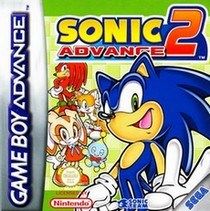 |
Turning to the portable titles, Dimps were immediately recomissioned in the light of the sales success of Sonic Advance, producing a sequel late in 2002 using the same engine. Although some alterations were made to the gameplay to incorporate elements from Sonic Adventure 2, such as Sonic’s use of stunt pads to launch himself into the air and an adjustment to the way the spin attack operated, the title was essentially more of the same, with a similar lack of inspiration in level design. The game was most notable for introducing a new character in the form of Cream The Rabbit, a six-year-old girl who took Amy’s place in the character roster. Cream is unique for two reasons; firstly, she has easily the worse character name in the Sonic canon (she sounds like the sort of instruction you’d get from Heston Blumenthal) and secondly she’s the only character to be shown as having a blood relation, with her prime motivation in the game being to rescue her mother, Vanilla. This doesn’t sound particular striking, but given Sonic Team’s reluctance to expound on its heroes’ origins, it stands as the only proof that Sonic characters don’t just pop out of thin air. Advance 2 again sold like hotcakes, and third effort would eventually appear in 2004, with a character swapping gimmick inspired by the “team battle” approach of Sonic Heroes. This was joined by Sonic Battle, a frankly bizarre isometric beat ‘em up for the handheld.
Another spin-off produced around the same time was Sonic Pinball Party for the GBA. Unlike Sonic Spinball, there was no plot attached to the game that simply included a pinball table themed around the Sonic series. Interest was further muted by the fact that it recycled art and sprites from Dimps’ Advance titles. With several years having elapsed since Sonic Jam, another retro pack was quickly released to consolidate the Sega’s presence on the Gamecube, containing the original four Mega Drive games. This was then converted to the Playstation 2 and Xbox, but of more interest is the follow-up that was released on the Nintendo system. Sonic Mega Collection 2’s main focus was a conversion of Sonic CD, but of more interest was the fact that Sonic The Fighters was finally available for a home system, complete with trimmings such as a versus mode. A port of Sonic R rounded out the package.
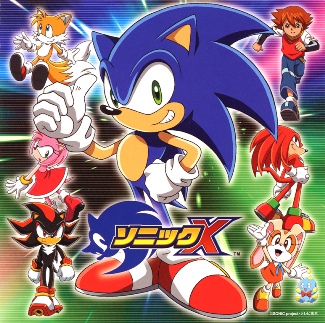 |
Although no fully-fledged game was released in 2003, it remains an important year for the character, due to the debut of Sonic X. A children’s cartoon series effectively masterminded by Sonic Team, the show’s premise saw the Sonic cast on earth, and having various misadventures while trying to adhere to their traditional M.O. in this setting. Sonic X may have been the fourth TV series to feature the character, but it’s by far and away the best, remaining true to the concepts of the games while creating its own unique setting. Sega’s involvement in the venture was extensive, with a soundtrack created by the Wavemaster studio and Yuji Naka undertaking promotional duties for the project. (He explained to fans that the series was not ‘canon’ as far as the games were concerned, taking place in “a different dimension”.) The principle addition to the games’ characters is Chris, a lonely rich kid who saves Sonic from drowning at the end of the opening episode, and whose house comes to be used as a base of operations by the forces of good. Although the boy’s parents make fleeting appearances when the plot requires, Chris’s eccentric inventor grandfather and the family’s samurai-obsessed butler take a more significant role. It short, it’s an utterly charming little show, with perfect characterisation throughout. Although initially commissioned for thirteen episodes, approval was quickly given for a full run of twenty-six, allowing the long-running plotline regarding Robotnik’s accumulation of the Chaos Emeralds to play out. Although the show isn’t high drama, there’s a trace of real emotion in the finale, which has Sonic and Chris both willing to sacrifice themselves to save the other.
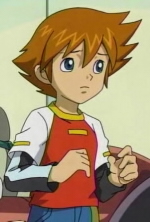 |
The commercial success of Sonic X was tremendous, with a considerable volume of merchandise shifted, far more than any iteration of the character has given rise to. A second run of 26 episodes was ordered, but the script team found themselves facing the problem that their originally planned story arc was complete, and they had few places left to take the show. This problem was partially resolved by using most of Season Two to present adaptations of the two Sonic Adventure games, although they suffered from the need to shoe-horn Chris into the existing plots. There’s an upswing in quality for the final ten original episodes (with a particularly amusing fourth-wall breaking debut for Chaotix, who had missed out of the action so far, and have to catch up on events by viewing the DVD releases), although the finale is effectively a reprise of the end of Season One.
In one respect, however, the second series of Sonic X performed an invaluable service to the character, providing the most sustained examination of his philosophy of life. In the final (original) arc of the series, the people of the world are beginning to mimic Sonic’s way of life, not bothering to attend work, and spending the day lazing around until something catches their attention. It’s eventually revealed that the problem is due to the effect of Super Sonic having merged two dimensions together at the close of the first series, but the spotlight it throws on the character is illuminating. It shows that the portrayal of the character throughout the show has been no accident. Unlike Tails, who has made a home for himself in the Grandfather’s workshop, Sonic has never sought a room in Chris’s house, being content to sleep outside and apparently not having any personal possessions. This supreme reluctance to be tied down in any way is perfectly consistent with the games, and goes a long way to explaining why the titles have seldom seen Sonic return to the location of a previous adventure. Sonic is effectively perpetually on holiday, always moving on and finding new places to explore and things to do. He is, however, indolent rather than hedonistic, being perfectly willing to doze the afternoon away rather than engaging in an activity that doesn’t interest him. He’ll pursue a goal with tenacity, but the essence of Sonic-ism is remaining unattached from life, appreciating the moment with little forward planning, with friends being the only link to the rest of the world. Tellingly, Sonic is never shown to acquire a house or even permanent residence in any of the games, in contrast to the other members of his cast. At the start of a story, his wondering is always bringing him to somewhere new, and he reacts to what he meets there. This distillation of his character may go some way to explaining why he proved so resistant to taking root in Japan- he’s the antithesis of his home nation’s work ethic and strong social identity, and a large part of the Sonic X story is that his actions are unsustainable in large sections of the population. The way Sonic relates to a human perspective on life, and his perpetual lack of attachment to others, would go on to be a key element of the story of Yuji Naka’s last adventure with his character, released in 2006.
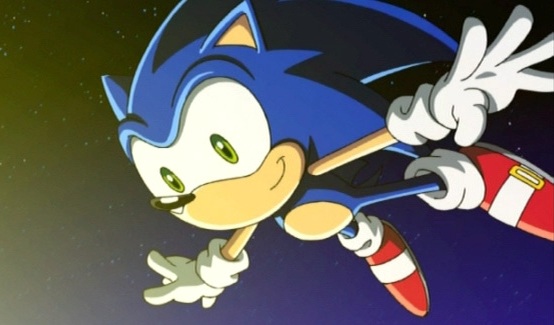 |
For most regions, the definitive conclusion for the show came at the end of Season Two, with Sonic and co returned to their home planet. In the US however, there was still much demand, and so a shorter US-exclusive Season Three was produced. This had stronger fantasy and sci-fi elements, being set on Sonic’s unnamed home world, to which the grown-up Chris has constructed a portal. The US enthusiasm for the series was also enough to sustain over twenty-five issues of a spin-off comic book from Archie, as well an bucketloads of action figures, cuddly toys and other paraphernalia.
One unfortunate consequence of Sonic X was sadly the sacking of the English vocal cast of the games. When Sonic X came to the west in 2004, localisation firm 4Kids declined to follow the example of the Japanese original series, and hire the actors who had voiced Sonic and co in-game, instead using their own performers. This aroused some disquiet amongst the Sonic fan community. Despite the poor work in the first Sonic Adventure, Ryan “Sonic” Drummond in particular had embraced the games’ community, being more than happy to give interviews to fan sites. What followed added insult to injury, with Sega of America then deciding to use the 4Kids performers in all games that followed after Sonic Heroes. This cost-saving measure has understandably lead to some bad blood between the fans and Sega US, although the quality of performances has remained largely unchanged. Jason Griffith’s Sonic sounds a little younger than Drummond’s, but that’s essentially the only difference.
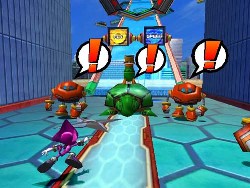 |
Despite sitting at the top of the second division of Sonic titles, Adventure 2 has been the subject of vicious character assassination since its release, with many decrying it as an unplayable mess. This opinion seems to have originated with the Gamecube release that followed six months after the Dreamcast version, with the game’s high speed momentum-based platforming a rather alien concept to the Mario-raised masses. Despite this, the Nintendo release of the title did the business at retail, and was enough to have Sonic Team USA recomissioned to provide the next fully-fledged title in the series, while an enhanced port of the original Sonic Adventure was put in development for the Gamecube and PC. After the expansiveness of Adventure 2, Takashi Iizuka and his fellow developers appear to have set their sights lower, with Sonic Heroes being conceived as a nostalgic look at the past of the series, with a return to the familiar checkerboard art direction. Although passing the “new levels” test (see Act 5) thanks to Giant Metropolis’s futurism and the haunted Mystic Mansion, the game is squarely conservative, with a minimal emphasis on story and attention paid to fixing legacy gameplay problems. The main innovation is allowing the player to control a team of three characters at once, with the primary character switched to give access to differing abilities. These powers were modelled after the lead ‘team’ with Sonic giving access to the standard high-speed platforming, Tails having limited flight abilities and Knuckles offering a range of combat options required to fight the more heavily armed badniks which populate the levels. Other teams have to flight their way through tweaked variants of the stages for Sonic’s squad. Team Dark poses the hardest challenge, lead by an amnesic Shadow, discovered to be held in stasis in one of Robotnik’s bases. He’s joined by Rouge and a psychotic and malfunctioning robot, E123. The remainder of the action is shared between Team Rose (Amy/Cream/Big) and a revived & redesigned Chaotix (Espio/Charmy/Vector).
The game has ‘old-school’ written all over it, with the plot obviously designed to appeal to fans. The story sees an apparently standard offensive by Robotnik revealed to be nothing of the sort, with the scientist held prisoner and impersonated by his upgraded Metal Sonic. The android has freed himself from loyalty to his creator and decided to eliminate all organic life, using Robotnik’s arsenal to do it. In the end, Super Sonic takes down his counterpart, who is recaptured and reprogrammed back into obedience by Robotnik. Impressively, the Sonic CD artist was recalled to create Metal Sonic’s matrix-inspired redesign, with a skirt section added to his armour for this one appearance only. Another pleasing factor is that the game follows the classic two acts & then a boss structure, although a last minute change saw the acts each being given seperate names, to allow the back of the box to boast of a total of fourteen levels. It’s interesting to hear Jun Senoue working with a more traditional style of game, while sticking to his guns on the use of guitars. The problem with Heroes is that Sega overreached themselves in their first truly multi-format title, with the bought-in Renderware engine producing a lacklustre mess. The handling of the characters never feels quiet right, with the homing attack lacking the crispness of its previous incarnations and the physics frequently giving the impression that every surface has been covered in butter. While its heart is in the right place, these technical and gameplay shortcomings means that Heroes is probably the weakest of the core series.
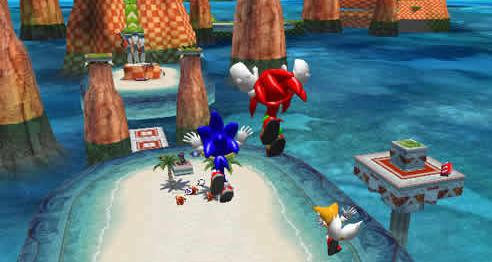 |
Next Time: No sex but lots of violence, as we examine the curious oddity of Shadow the Hedgehog. And if you thought that was weird, just wait until we look at Sonic’s 360/PS3 début…
About this entry
- By Julian Hazeldine
- Posted on Sunday, August 02 2009 @ 7:16 pm
- Categorised in Games, Analysis
- Tagged with sonic the hedgehog, Sonic Adventures, Sega
- 0 comments
